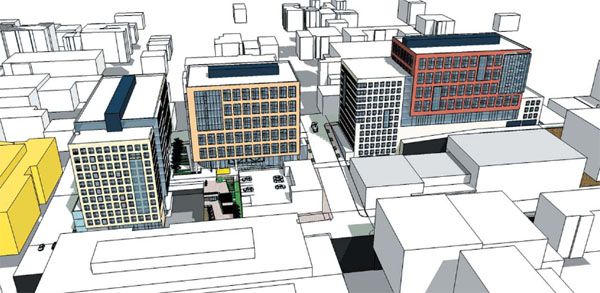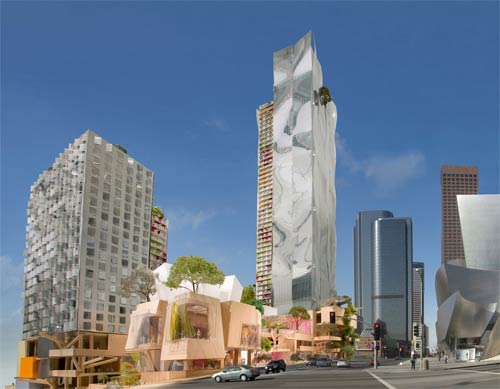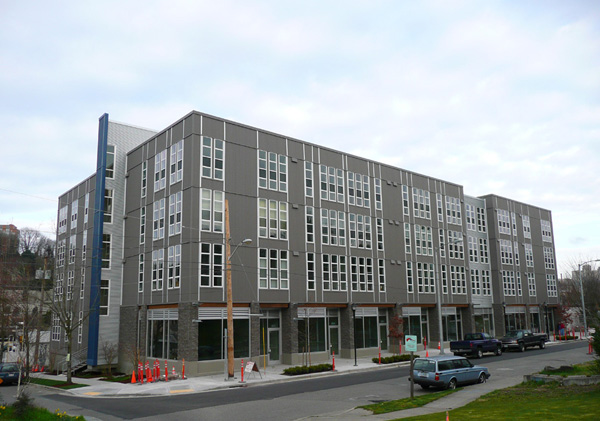Wednesday, April 2, 2008 | posted by dan bertolet | Comments Off on Terminal 46 Has Arisen, Not So Much

I had a premonition. Terminal 46 has been pulled back out of the memory hole by the folks who want to bring us “Emerald City Center.” They don’t have any land or funding, but they think Terminal 46 would make a dandy location for the multi-sports and cultural complex rendered above. Oh, and they haven’t gotten around to asking the Port of Seattle if that would be OK.
All I have to say is I think it looks like a cross between a horseshoe crab and a pillbug.
Tuesday, April 1, 2008 | posted by dan bertolet | Comments Off on What’s Even Huger Than Hugeass?

[ “Hydropolis,” assembled in Germany, shipped to Dubai, will be the world’s first underwater hotel. ]
Dubai. Yep, you’ve heard about it, but you best be taking a look at this astounding summary.
Alas, Dubai, apparently your 3400-foot Al Burj tower won’t be the tallest for very long. “Mile High Tower” is coming to Jeddah, Saudi Arabia. Say it with me now: WTF?! But even wiki says it’s true.
Hmm. A mile-high tower in the desert. Golly, is that sustainable?

[ Image: Skyscrapercity ]
Tuesday, April 1, 2008 | posted by MJH | Comments Off on What it Takes
Â
 
Velib – Paris’ “Bicycle Transit System”
San Francisco is finally getting around to updating its 1997 bike plan. It plans to add 34 miles of bike lanes, almost doubling what it currently has. And to do it, they are looking at removing curbside parking and traffic lanes in some cases. That’s what it takes to make a system that the masses are willing and able to use. Squeezing drivers and bicyclists onto streets that are already narrow compared to other cities, using sharrows, and narrow bike lanes are half measures only. But that’s old news. Meanwhile world class cities such as London and Paris not only see biking as a critical measure for reducing GHG emissions, but they see it as an economic engine. London unveiled its plan to encourage more bicycling last month and last year Paris launched Velib, a self-service “bicycle transit system.” The system includes over 20,000 bikes, at 1,451 stations that are no more than 900 feet apart. What’s it going to take in Seattle? Ideas abound, but leadership doesn’t.
Tuesday, April 1, 2008 | posted by dan bertolet | Comments Off on Seattle Takes a Step Toward GHG Regulation
In past posts I’ve been critical of Seattle’s progress toward mandating green development, so I can’t let this pass: As of yesterday, Seattle will require greenhouse gas (GHG) emissions evaluations for every project large enough to trigger a SEPA review. (Residential projects with four units or less, and commercial projects 4000 square feet or less are typically exempt from SEPA.)
Next step will be to establish how much GHG emissions is too much, and then give the regulation some teeth to deny permits to projects that are over that limit. That promises to be a rocky road, but one we have to get over.
Sunday, March 30, 2008 | posted by dan bertolet | Comments Off on Oxymoron of the Day: Green Consumer
Consume = use up = unsustainable. Nuff said?
Yes, yes, yes, I know, I know, of course it’s a good thing that people are becoming more conscious of the impacts of their purchases. But, call me a curmudgeon (or worse), I just can’t stand marketing verbage like this:
“Green Festival, the largest and most authentic green consumer event in the world.”
How sad that even the folks who are out there working so hard to promote green lifestyles are still propagating our culture’s perverse view that a person is nothing more than a consumer. Because that’s precisely the attitude we have to lose if we ever hope to create a truly sustainable society. Calling someone a consumer should be an insult.
I don’t mean to bash Green Festival — they’re doing great work. But what keeps niggling away at me is this impression that the popular green movement is creating a false sense of complacency, that if we could all just become green consumers everything will be OK and we won’t have to make any major changes or serious sacrifices. To put that in perspective, witness the mass howling that ensues when, for example, it is proposed that car capacity be reduced in order to encourage more sustainable modes of transportation.
And then at times I think to myself, “just relax, people are changing, it’s all good.” But even Alan Durning of Sightline, known for his restrained wisdom and positive attitude, apparently isn’t letting people off the hook that easily, to judge by this quote in a recent Seattle PI article about green building:
“People are capable of holding wildly contradictory beliefs. There is this sort of pastoral ideal that you will live in a place set in parkland like French royalty, and you are a good responsible REI member, and green Northwesterner. So your Land Rover has mute Earth tones, and you probably buy organic pet food for your Labrador retriever.”
Sunday, March 30, 2008 | posted by dan bertolet | Comments Off on First Peek at Amazon’s New SLU Headquarters

[ Boren Ave N., between John St and Harrison St, looking West ]
Shown above is the initial concept(pdf) for Amazon’s new headquarters in South Lake Union, to be presented at the Early Design Guidance meeting on April 2. This project owes its existence to a two-block, rezone granted by the City Council last December that raised the building height limits from 65 and 85 feet to 160 feet.
The architect is Callison, and LEED Silver is being targeted. The 11-story building to the south, known as block 35, will be the first phase, with 328k square feet total, of which 151k sf is parking (500 stalls), and 4500 sf is retail.

[ View looking East ]
Update: Since it’s so early in the process, I was going to refrain from commenting on the design, but… for the biggest and most well known online bookstore on the face of the planet, wouldn’t one expect a world headquarters that was a little more architecturally adventurous, a little more iconic, perhaps? What they’re showing so far is totally generic office building. Why not, say, a building that looks like a row of books on a bookshelf? Or something crazier. Where is the sense of pride? Or at least sense of humor or fun. Amazon is a phenomenal success story. I say let that big ego fly.
Saturday, March 29, 2008 | posted by dan bertolet | Comments Off on Walking the Talk on Water
“Water is the new energy.”
So says my architect friend Rob Harrison, as quoted in the April issue of Metropolitan Home magazine. It’s a quip that may seem hyperbolic, or perhaps a little too cute. But not if you ask the United Nations. Expect to be hearing a lot more about “water footprint” in the not too distant future.
As CO2 emissions receive more and more of our attention, we must be careful not to neglect other critical resource issues, such as water. Indeed, in some cases CO2 emissions and water use are directly antagonistic. UNESCO-ITE recently found that biofuels are 70 – 100 times more water intensive to produce than are fossil fuels. In other words, biofuels may reduce your carbon footprint, but they also increase your water footprint.
Unfortunately, the semiconductor processing used to produce photovoltaic solar cells is also highly water intensive. I have not come across any analysis of this tradeoff, but if anyone out there has, please chime in.
Here in the Pacific Northwest, there is a particularly tangled web entwining energy use, CO2 emissions, and water. It has been recognized for many years that global warming will reduce snowpack in the Cascades, which will not only put the squeeze on Summer potable water supplies, but will also diminish flows through our hydroelectric dams, which, in turn, will force us to resort to using other, more CO2 intensive electricity sources, which will produce more global warming, etc, etc…
Thursday, March 27, 2008 | posted by dan bertolet | Comments Off on Ahoy There Planning Wonks: Tell Us What’s Good or Bad About Seattle’s Multifamily Zoning Update

[ Diagram illustrating proposed affordable housing height bonus ]
The process of updating Seattle’s multifamily zoning code has been underway since 2005, the most recent milestone being the environmental determination of non-significance issued on December 7, 2007. The proposed ordinance will be put before the City Council in Spring of 2008.
I was recently reminded of the update process by the Seattle Community Council Federation (SCCF), which issued an “alert” that was picked by several neighborhood blogs, see here, here, and here. And so I spent a little quality time with SCFF’s screed, as well as with the City’s documents.
To me, the City’s proposed changes seem reasonable and well thought out overall. On the other hand, while I respect SCFF’s intentions, I found much to disagree with in their criticisms. I’m inclined to be a little more restrained than Will at Horse’s Ass, but it was definitely disappointing how SCFF seemed to be so hung up on tired misconceptions about density (this subject deserves its own blog post), and to have such kneejerk negative reactions to new concepts such as the “Green Factor.”
The Squire Park Community Council has also published multifamily update recommendations, which I find to be relatively sensible and well-stated. Their main goals are to preserve existing housing stock, to create smaller, more affordable units, and to create more aesthetically pleasing buildings. To these ends they recommend density bonuses for (1) new units that preserve existing housing, (2) smaller units, and (3) green building, as well parking requirement reductions and the allowance for accessory dwelling units.
Anyhoo, here are a few of my favorite items in the City’s proposed update:
- zero parking requirement in urban centers
- height bonus for affordable housing
- 4-foot fence height limit in front setbacks
Nothing stood out to me as an obviously bad idea (though admittedly, I didn’t exactly linger over the documents — life’s too short, no?). So then, precious wonks who are still reading, what am I missing?
Tuesday, March 25, 2008 | posted by dan bertolet | Comments Off on Development Memory Hole: Terminal 46
Remember four or five years ago when everyone was hot for Terminal 46? But the Port of Seattle didn’t want to play, so all we’ve got to show for it are these pretty pictures:

[ Nitze-Stagen’s vision for Terminal 46; rendering by William Hook ]

[ Rendering from Allied Arts 2004 Waterfront Design Charette ]

[ Rendering from Allied Arts 2004 Waterfront Design Charette ]

[ 3D model from 2004 University of Washington Urban Design Studio ]
Sunday, March 23, 2008 | posted by dan bertolet | Comments Off on More Affordable Housing at Jackson Place

Construction is about to begin on HomeSight’s 102-unit Pontedera Condominiums and Lofts, rendering above, located at Hiawatha Place and Dearborn St in the Jackson Place neighborhood. Half of the units will be affordable to families earning less than 80% of the area median income, and half will be sold at market rate. The March Jackson Place newsletter reports that, “low-interest deferred mortgages and reduced down payments will be available to those who qualify and the building will receive a property tax exemption.”
The Pontedera will be the third affordable housing project in this little corner of Jackson Place: right next door to the south is Hiawatha Artists Lofts, and a block east on Davis Place is The Stellina, also developed by HomeSight. Adding to the eclectic mix of housing is Jackson Place Cohousing, on the east side of Hiawatha Place.
The unlikely location of all this affordable housing is the result a strategy to redevelop 3.5 acres that the City acquired during the construction of I-90. It is a good example of how all the planets need to be aligned for affordable housing projects to succeed. As proposed here, Seattle could well use a development authority to help affordable housing projects leverage all the available incentives, as well as to advocate for new and improved incentives.
A side note: Considering the unusual nature of the housing noted above, and the time and care it took to make it happen, I find it easier to appreciate the neighborhood’s criticisms of the proposed development at the Goodwill site just across Rainier Ave. As of February, both the Jackson Place and Squire Park community councils continue to oppose the development because the “size and character are unacceptable.” According to the Jackson Place newsletter, “the project is currently being held up by the City because it is seeking written assurances that the housing will be completed as part of the project.”
Friday, March 21, 2008 | posted by dan bertolet | Comments Off on Los Angeles, Dubai, and Tent Cities

This is Frank Gehry’s $2 billion vision for Grand Avenue in downtown LA adjacent to the Disney Concert Hall. The project had been stalled by financing setbacks related to the real estate slowdown, but construction is finally set to begin after $100 million of funding was secured from the Royal family of Dubai.

Meanwhile, the BBC reports that “tent cities have sprung up outside Los Angeles in the US as people lose their homes in the mortgage crisis:”
http://www.youtube.com/watch?v=CnnOOo6tRs8
The footage is from the homeless tent city in Ontario, CA, about an hour east of LA. The camp has grown from 20 to 400 in nine months.
Hello Blade Runner.

[ Tent city in Ontario, CA; photo: LA Times ]
Friday, March 21, 2008 | posted by WB | Comments Off on Big Bad House

Built in 2007, I simply ask the question, why? Unfortunately, this is my generation’s legacy, to surely be looked back upon in disgust. Imagine if at the turn of the century the beautiful neighborhoods that populate Capitol Hill or Queen Anne, as examples, were filled with the abortion of style this house represents. What’s happened? The homeowners obviously had enough money to build anything they wanted — why is there such an utter lack of understanding of form, material, and proportion in today’s residential design community?
Thursday, March 20, 2008 | posted by Joshua | Comments Off on Housing, Political Courage, and Thinking Outside the Box

On Tuesday night’s
Housing Forum put on by the
Seattle Great City Initiative, a panel consisting of Tony To, Charlie Royer, Maria Barrientos, and Sally Clark participated in an often lively discussion on what Seattle needs to do to meet our housing shortages in a sustainable manner (disclaimer: I’m Vice-Chair of the SGCI Steering Committee).  There was some great perspectives offered, but I wanted to touch on Charlie Royer’s comments towards the end. He said (and I’m paraphrasing), “It’s not an alternative for people to want or not want more housing. It needs to happen [referring to global warming]. And the City of Seattle needs the political courage to make this happen.” The crowd erupted in applause; Sally Clark kept her head down but nodded attentively. Royer was right on the money. We need more political courage in Seattle. Anyone who recently heard Obama’s
speech on race now knows what political courage looks like. You know what else we need? Thinking outside of the box. They go hand in hand. So what would it look like here? Here are a few things a politician could say (in my fantasy world):
- Our zoning code won’t get us from here to there (if “there” is a creative, vital, sustainable city). In fact, Euclidean zoning doesn’t work. It’s a limited, anachronistic, “blunt” tool that should have no place in today’s drive towards sustainable urban spaces. It is inherently built to pit developers against the city, neighborhoods against the developer, etc. We’re better than that. Tools such as performance zoning allow cities to develop goals and encourage builders to meet these goals while allowing them more room for creativity to get there. Instead of telling people what the WRONG result is, why don’t we give them the impetus to do the RIGHT thing. We’re not going to switch overnight, but why not develop a second track that gives a “fast tracking” option to developers who think they can deliver better goods than what the current code allows? If it works, we phase over to that system over time.
- We have poor design standards. One of the reasons some people have reacted so vehemently to increased density is because of the “scourge” of townhomes. The City of Portland has held design competitions to develop different design schemes that can be downloaded from their website. Again, we know what sucks – let’s show what doesn’t.
- We need TIF, and we need a development authority was some, er, cohones. One of the reasons that projects such as this are able to happen is through multiple sources of funding. TIF is such a source, and having a development authority with a series of mandates that reflects the multiple layers of action needed (let’s call it the “Seattle Sustainable Development Commission”) would allow leverage of federal and state funds, city land, and other resources to really be proactive. Tools such as multifamily tax abatements, incentive zoning, etc are useful, but they pale in comparison to a fully funded, quasi-governmental development authority with TIF powers. Until then, we’re just piddling at the corners.
So, yes, we need political courage and thinking outside of the box. We need to be proactive and stop with the lipstick on the pig. But Royer had another good point. Politicians need political support. Who’s going to give it to them?
Wednesday, March 19, 2008 | posted by dan bertolet | Comments Off on The Devils and Details of Belltown

[ Site 17 North, at Western Ave. and Wall St. in Belltown ]
I like it. Because, unlike Belltown Court (see previous post), there is life and vision in its design, from the massing and form, down to the detailing.
A big reason why so many people react negatively to new development is the lack of quality detailing. Why is it that subtle and rich detailing, such as you tend to find on the older brick buildings, is so much less common today? This contrast is well illustrated here.
It’s a complex question, but I believe that overall it is a reflection of a culture that, as it has become ever more utilitarian, is forgetting how to value what can’t be quantified. When a building is designed and built by a culture in which the bottom line rules, it shows. In contrast, cultures that value human realms beyond the material tend to produce buildings that people love.
Tuesday, March 18, 2008 | posted by dan bertolet | Comments Off on Belltown Preference Survey
Choose one:
The new Belltown…

or the old Belltown…

Tuesday, March 18, 2008 | posted by dan bertolet | Comments Off on Gray (Affordable Housing for Artists)

Artspace, the folks who developed Tashiro Kaplan Artist Lofts in Pioneer Square, are just finishing their second Seattle project, Hiawatha Lofts, a block southeast of Rainier Ave. and Dearborn St. The building houses 61 low-income artists lofts, 5000 square feet of retail space, and 54 underground parking stalls. Designed by SMR Architects, who specialize in low-income housing and historic preservation; project cost: $17 million.
Yes, she’s a gray lady, all gray but for a splash of intense blue on either end, and the brown wood lintels over the storefronts. And all those white window mullions, which, while they do have that cheap vinyl look, also give the facade an unusual and satisfying rhythm and texture.
A gray building in gray Seattle. So be it. The art inside can provide the color. Overall, I think this building is successful architecturally because it is based on a few simple and strong ideas: a clean and crisp 4-story box; gray metal siding; tall and skinny floor-to-ceiling windows. No doubt this project had a very tight budget, all the more reason to stick with simple design elements.
Seattle needs more low-income housing projects like this — so how did it happen? First of all, the City of Seattle gave the land (valued at $1.7 million) to the developers in exchange for the guarantee that the low-income housing will be available for 75 years. The project also requested $3 million from the City’s 2002 affordable housing levy. The State chipped in $1 million, and the Paul G. Allen Family Foundation contributed $400,000. All in all, it appears that roughly one third of the project cost was subsidized.
And that’s the bottom line: If we want affordable housing built in Seattle, it will have to be heavily subsidized. Socialism is us.
Monday, March 17, 2008 | posted by dan bertolet | Comments Off on The Unsettling of America

by Wendell Berry, published 31 years ago:
‘It is no doubt impossible to live without thought of the future; hope and vision can live nowhere else. But the only possible guarantee of the future is responsible behavior in the present. When supposed future needs are used to justify misbehavior in the present, as is the tendency with us, then we are both perverting the present and diminishing the future. But the most prolific source of justification for exploitive behavior has been the future. The exploitive mind characteristically puts itself in charge of the future. The future is a time that cannot conceivably be reached except by industrial progress and economic growth. The future, so full of material blessings, is nevertheless threatened with dire shortages of food, energy, and security unless we exploit the earth even more “freely,” with greater speed and less caution. The obvious paradoxes in all this–that we are using up future necessities in order to make a more abundant future; that final loss has been made a calculated strategy of annual gain–have so far been understood to no great effect. The great convenience of the future as a context of behavior is that nobody knows anything about it. No rational person can see how using up the topsoil or the fossil fuels as quickly as possible can provide greater security for the future; but if enough wealth and power can conjure up the audacity so say that it can, then sheer fantasy is given the force of truth; the future becomes reckonable as the past has never been. It is as if the future is a newly discovered continent which the corporations are colonizing. They have made “redskins” of our descendants, holding them subject to alien values, while their land is plundered of anything that can be shipped home and sold.’
Monday, March 17, 2008 | posted by WB | Comments Off on How Greatness In Architecture is Born
Sunday, March 16, 2008 | posted by dan bertolet | Comments Off on Seattle Coffee Works Buys Rights to Hammering Man

Not. But would anyone be that surprised if at some point in the not too distant future it was officially renamed the Starbucks Hammering Man?
Regarding Seattle Coffee Works: they are serving up some serious espresso. On that funky block on Pike between 1st and 2nd, right next door to the obnoxious 50’s rock and roll blaring from Johnny Rockets. Look for the black and orange coffee man on the sidewalk.
Sebastian typically has 7 or 8 grinders set up with different beans and blends to choose from. It’s like a wine tasting. And the doppios that he makes are consistently the best I’ve had anywhere.
So good that I’ll risk this declaration: Seattle Coffee Works has the best coffee in Seattle. Anyone out there have problem with that?

[ The grinder line-up in Seattle Coffee Works ]
Saturday, March 15, 2008 | posted by dan bertolet | Comments Off on Yellow

[ Rendering: Group Architect ]
Like a hornet. Like a crayola crayon. Pure, saturated, unapologetic yellow. Five uninterrupted stories of it, no less. And, OMG, it’s right next to traditional brick apartment buildings on both sides. Seattle, are you going to stand for it, this boldness, this blatant disrespect for context?
This happy yellow thing proposed for the corner of Thomas and Melrose on the west edge of Capitol Hill will house 30 apartments and 32 below grade parking stalls; designed by Group Architect. Final design review (big pdf) is March 19.
Perhaps not the most elegant design, but I’ll take simple over cluttered and confused. And check out the size of those balconies — they are requesting a departure to allow them to protrude so close to the property line.
So what are the odds that all that yellow will end up on the finished building?


























